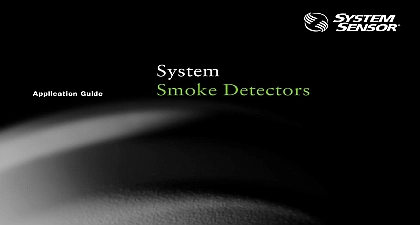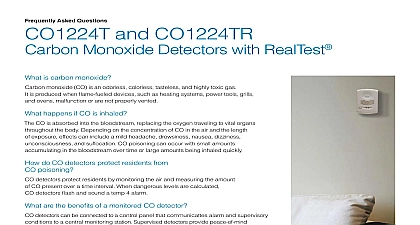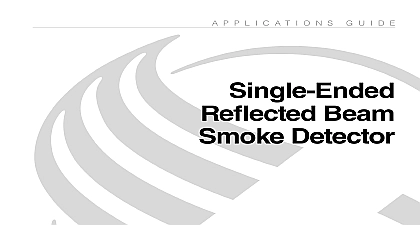System Sensor System-Connected CO Detectors

File Preview
Click below to download for free
Click below to download for free
File Data
| Name | system-sensor-system-connected-co-detectors-9681745230.pdf |
|---|---|
| Type | |
| Size | 860.54 KB |
| Downloads |
Text Preview
A P P L I C A T I O N S G U I D E Monoxide Y S T E M S E N S O R Monoxide 2 Oxide Semiconductor CO Detector Operation 4 1 Standards That Apply 2 CO Detector Operation 4 Laboratories 2 Life of System Connected CO Detectors 4 2 Carbon Monoxide Overview 3 4 Installation Guidelines 6 is CO 3 and Spacing 6 CO Affects the Human Body 3 5 Testing Maintenance and Service of Detectors 7 Soures of CO 3 Inspection Testing and Maintenance Practices 7 3 How Carbon Monoxide Detectors Work 4 CO Detector Operation 4 use of early warning carbon monoxide CO detectors can result in a significant reduction of CO related poisonings and death Furthermore monitored carbon monoxide detection provides an extra level of protection for building residents or occupants who cannot appro respond to a local CO detection alarm The sooner occupants and authorities are notified of dangerous CO levels in a given environment the the outcome for avoiding serious injury or death This document provides guidance for the proper operation of system connected CO detectors installation and maintenance of CO detectors helps prevent unwanted alarms and ensures proper functioning of devices The latest generation CO detectors when installed and maintained properly significantly limits the nuisance alarms that initially desensitized occupants when repeated alarms occurred in earlier generation CO detectors Today CO detection devices are effective trustworthy and the only means to detect the tasteless and deadly carbon monoxide gas P P L I C A T I O N S G U I D E S Y S T E M C O N N E C T E D C A R B O N M O N O X I D E D E T E C T O R S purpose of this guide is to provide information on the proper appli of system connected carbon monoxide CO detectors in ordinary locations not to meet outdoor EPA or indoor OSHA requirements guide outlines basic principles and standards that should be consid in the application of early warning CO detection devices in relation to characteristics and effects of CO gas 1 and Standards That Apply Code Council ICC ICC publishes numerous codes used to construct all residential and commercial buildings A code specifies WHEN what type CO detection is required and the location of CO detectors Fire Protection Association NFPA Park MA 02269 9101 publishes standards for the proper application installation and main of CO detection NFPA 720 2015 is the Standard for the Installation Carbon Monoxide CO Detection and Warning Equipment A standard HOW carbon monoxide detection and warning equipment is to installed tested maintained and monitored 1.1.1 is primarily concerned with life safety not with protection of 1.1.2 covers the selection design application installation loca performance inspection testing and maintenance of CO detection warning equipment in buildings and structures 1.1.3 contains requirements for the selection installation opera and maintenance of equipment that detects concentrations of CO that pose a life safety risk to most occupants in buildings and structures 1 Defines CO detector location more specifically than ever In commer buildings CO detectors need to be located on the ceiling in the room as permanently installed fuel burning appliances They also to be centrally located on every habitable level and in every HVAC of the building In dwelling units CO detectors must be installed each separate sleeping area and on every level of a dwelling including basements Applicable laws codes and standards may additional locations Requires CO detection systems to have sufficient secondary power to the system under quiescent load system operating in normal for at least 24 hours After that time the system must operate of the CO notification appliances for 12 hours if a supervising station not monitor the system If monitored by a supervising station the requirement can be reduced to 5 minutes Includes CO detector testing requirements However the requirement to able to functionally test the CO detector in a manner similar to test smoke detectors with canned smoke Note that the System Sensor with RealTest meets this testing requirement CO detectors shall be replaced when the end of life signal is activated the manufacturer replacement date is reached or when they fail to respond to operability tests Clarifies what supervising stations should do when they receive a CO signal If the communications methodology is shared with any usage all fire alarm CO alarm supervisory and trouble signals take priority in that order of priority over all other signals unless oth permitted by the AHJ The integral sounder of a CO detector may be sufficient for notifying of commercial and residential buildings It allows occupant to be limited to the notification zone encompassing the area the CO signal is originated if the CO alarm signal is transmitted a constantly attended onsite location or off premises location of the new standards which should be reviewed in their entirety specifying or installing CO detectors follow NFPA 720 2015 Laboratories laboratories test smoke detectors CO detectors control panels other components of fire alarm systems to verify conformance with requirements and their own standards Equipment that passes their is identified by a label and or listing Nationally standardizes CO detection for all buildings not just res This includes schools hotels nursing homes apartment and other commercial structures Requires CO alarm signals to be distinct and annunciated fire alarm CO supervisory and CO trouble signals Furthermore CO alarm signal should take precedence over supervisory or trou signals CO detector trouble signals must be indicated visually and at the control panel and supervising station Therefore the CO must have a means to signal the panel upon trouble condi For example hardwired detectors require an integral trouble relay send the trouble signal to the panel Now holds CO detectors to the same life safety standard as smoke They will send trouble signals to the control panel and facili wiring supervision Laboratory Drive P O Box 13995 Triangle Park NC Laboratories Inc UL Pfi ngsten Road IL 60062 E Trimble Road Jose CA 95131 Walt Whitman Road NY 11747 N W Lake Road WA 98607 National Fire Protection Association NFPA 720 Standard for the Installation of Carbon Monoxide CO Detection and Warning Equipment Scope NFPA org http www nfpa org aboutthecodes AboutTheCodes asp DocNum 720 cookie test 1 See page 7 for information on CO for worker safety following UL standards apply to CO detectors Sources of CO Y S T E M S E N S O R 2075 is the product standard for CO detectors connected to a con panel via conductors or low power radio frequency wireless 2034 is the product standard that covers self contained CO alarms are not designed or listed to be connected to a control panel is important to note that the alarm thresholds of UL 2034 CO alarms and 2075 CO detectors are the same Section 15.1 b of UL 2075 requires to operate within the sensitivity parameters defined by UL 2034 38.1 of UL defines the actual alarm thresholds which are 30 ppm no less than 30 days 70 ppm 60 to 240 minutes 150 ppm 10 to 50 minutes


